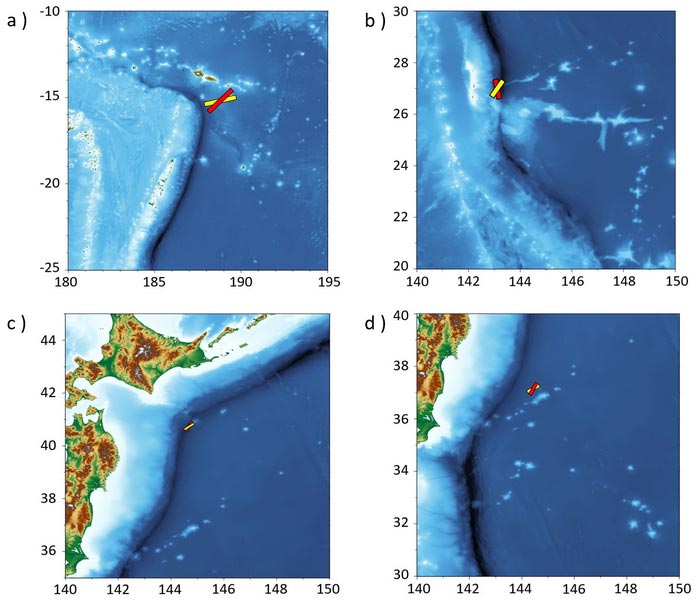Creating a tsunami early warning system

This study investigates four different past earthquake scenarios associated with tsunami events. The red and yellow rectangles represent the projected earthquake dimensions, locations, and orientations retrieved by the proposed inverse model for acoustic radiation. The analyzed earthquakes are: a) Sept. 29, 2009, Mw 8.1, SSW of Matavai, Samoa; b) Dec. 21, 2010, Mw 7.4, Bonin Islands, Japan region; c) March 14, 2012, Mw 6.9, SSE of Kushiro, Japan; and d) Oct. 25, 2013, Mw 7.1, off the east coast of Honshu, Japan. The model delivers two potential fault orientations for each earthquake scenario, which are numerically modeled and compared.
Credit: Bernabe Gomez and Usama Kadri
… using artificial intelligence.
Real-time classification of underwater earthquakes based on acoustic signals enables earlier, more reliable disaster preparation.
Tsunamis are incredibly destructive waves that can destroy coastal infrastructure and cause loss of life. Early warnings for such natural disasters are difficult because the risk of a tsunami is highly dependent on the features of the underwater earthquake that triggers it.
In Physics of Fluids, by AIP Publishing, researchers from the University of California, Los Angeles and Cardiff University in the U.K. developed an early warning system that combines state-of-the-art acoustic technology with artificial intelligence to immediately classify earthquakes and determine potential tsunami risk.
Underwater earthquakes can trigger tsunamis if a large amount of water is displaced, so determining the type of earthquake is critical to assessing the tsunami risk.
“Tectonic events with a strong vertical slip element are more likely to raise or lower the water column compared to horizontal slip elements,” said co-author Bernabe Gomez. “Thus, knowing the slip type at the early stages of the assessment can reduce false alarms and enhance the reliability of the warning systems through independent cross-validation.”
In these cases, time is of the essence, and relying on deep ocean wave buoys to measure water levels often leaves insufficient evacuation time. Instead, the researchers propose measuring the acoustic radiation (sound) produced by the earthquake, which carries information about the tectonic event and travels significantly faster than tsunami waves. Underwater microphones, called hydrophones, record the acoustic waves and monitor tectonic activity in real time.
“Acoustic radiation travels through the water column much faster than tsunami waves. It carries information about the originating source and its pressure field can be recorded at distant locations, even thousands of kilometers away from the source. The derivation of analytical solutions for the pressure field is a key factor in the real-time analysis,” co-author Usama Kadri said.
The computational model triangulates the source of the earthquake from the hydrophones and AI algorithms classify its slip type and magnitude. It then calculates important properties like effective length and width, uplift speed, and duration, which dictate the size of the tsunami.
The authors tested their model with available hydrophone data and found it almost instantaneously and successfully described the earthquake parameters with low computational demand. They are improving the model by factoring in more information to increase the tsunami characterization’s accuracy.
Their work predicting tsunami risk is part of a larger project to enhance hazard warning systems. The tsunami classification is a back-end aspect of a software that can improve the safety of offshore platforms and ships.
The article “Numerical validation of an effective slender fault source solution for past tsunami scenarios” is authored by Bernabe Gomez and Usama Kadri. It will appear in Physics of Fluids on April 18, 2023 (DOI: 10.1063/5.0144360). After that date, it can be accessed at https://doi.org/10.1063/5.0144360.
ABOUT THE JOURNAL
Physics of Fluids is devoted to the publication of original theoretical, computational, and experimental contributions to the dynamics of gases, liquids, and complex fluids. See https://aip.scitation.org/journal/phf.
Journal: Physics of Fluids
DOI: 10.1063/5.0144360
Article Title: Numerical validation of an effective slender fault source solution for past tsunami scenarios
Article Publication Date: 25-Apr-2023
Media Contact
Ashley Piccone
American Institute of Physics
media@aip.org
Office: 301.209.3090
All latest news from the category: Information Technology
Here you can find a summary of innovations in the fields of information and data processing and up-to-date developments on IT equipment and hardware.
This area covers topics such as IT services, IT architectures, IT management and telecommunications.
Newest articles

Largest magnetic anisotropy of a molecule measured at BESSY II
At the Berlin synchrotron radiation source BESSY II, the largest magnetic anisotropy of a single molecule ever measured experimentally has been determined. The larger this anisotropy is, the better a…

Breaking boundaries: Researchers isolate quantum coherence in classical light systems
LSU quantum researchers uncover hidden quantum behaviors within classical light, which could make quantum technologies robust. Understanding the boundary between classical and quantum physics has long been a central question…

MRI-first strategy for prostate cancer detection proves to be safe
Active monitoring is a sufficiently safe option when prostate MRI findings are negative. There are several strategies for the early detection of prostate cancer. The first step is often a…



